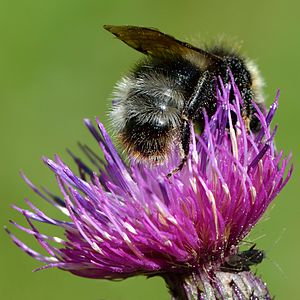Forest cuckoo bumblebee
| Forest cuckoo bumblebee | ||||||||||||
|---|---|---|---|---|---|---|---|---|---|---|---|---|

Male on marsh thistle |
||||||||||||
| Systematics | ||||||||||||
|
||||||||||||
| Scientific name | ||||||||||||
| Bombus sylvestris | ||||||||||||
| ( Lepeletier , 1832) |
The forest cuckoo bumblebee ( Bombus sylvestris ) is a species of bumblebee that lives as a breeding parasite .
features
The female becomes 14-16 mm long and has a wingspan of 32-35 mm, the male 13-15 mm with a wingspan of 27-30 mm. The forest cuckoo bumblebee is black with the exception of a yellow cross band behind the head and the shaggy, white-haired rear third of the abdomen and is very similar to its main host, the meadow bumblebee . In this case, however, the end of the abdomen is orange-red. The queen of the meadow bumblebee has a relatively high humming sound, the forest cuckoo bumblebee a relatively deep one, similar to that of the much larger 'dark earth bumblebee'. The rounded head and trunk are short. It lacks the pollen collecting device on the last pair of legs, which is typical of bumblebees, which would be necessary to take care of the larvae themselves.
Occurrence
The forest cuckoo bumblebee lives in Northern Europe and Siberia as far as the Pacific , in all of Central Europe and in the higher altitudes of Southern Europe .
Reproduction
The forest cuckoo bumblebee mainly parasitizes the meadow bumblebee , but also tree and stone bumblebee , and more rarely the heather bumblebee . In April, when the first female workers of her host population have hatched, she flies close to the ground in search of a suitable bumblebee nest. It invades the nest and behaves inconspicuously until it has accepted the smell of its host. Then she fights with the queen of the host people, which she usually wins. The chitin shell of the forest cuckoo bumblebee is much stronger than that of the parasitized queen and difficult to penetrate. A bumblebee sting is fatal to a bumblebee. She then destroys her host's brood cells, consumes the host queen's eggs and creates her own brood cells to lay her eggs there. Only sex animals hatch from the eggs, i.e. drones and queens, but no workers. The developing larvae are supplied with nectar and pollen by the workers of the host colony. After mating, the male dies and the female overwinters in a protected hiding place in the ground. But not every attempt at conquest is successful. The tree bumblebee workers in particular are usually very vigilant and ready to defend themselves. The intruder then occasionally dies.
Flight time
The overwintered forest cuckoo bumblebee flies from April to the end of July, the young female from July and the young male from mid-July. The species is univoltine and therefore only occurs with one generation per year.
nutrition
In spring, the female often feeds on pollen and nectar from dandelions , widow flowers and blood currants , the male mostly on thistles , knapweeds and scabiosis .
Individual evidence
- ↑ a b c d e H.-J. Martin: Forest Cuckoo Bumblebee: Bombus sylvestris . In: www.wildbienen.de . ( Online [accessed October 24, 2007]).
- ↑ Heiko Bellmann : Bees, Wasps, Ants - The Hymenoptera of Central Europe , Franckh-Kosmos, Stuttgart 2002, p. 319, ISBN 3-440-06932-X
- ↑ a b Melanie von Orlow: Kuckuckshummeln . In: www.hymenoptera.de . ( Online [accessed October 25, 2007]). Online ( Memento of the original from July 24, 2015 in the Internet Archive ) Info: The archive link was inserted automatically and has not yet been checked. Please check the original and archive link according to the instructions and then remove this notice.